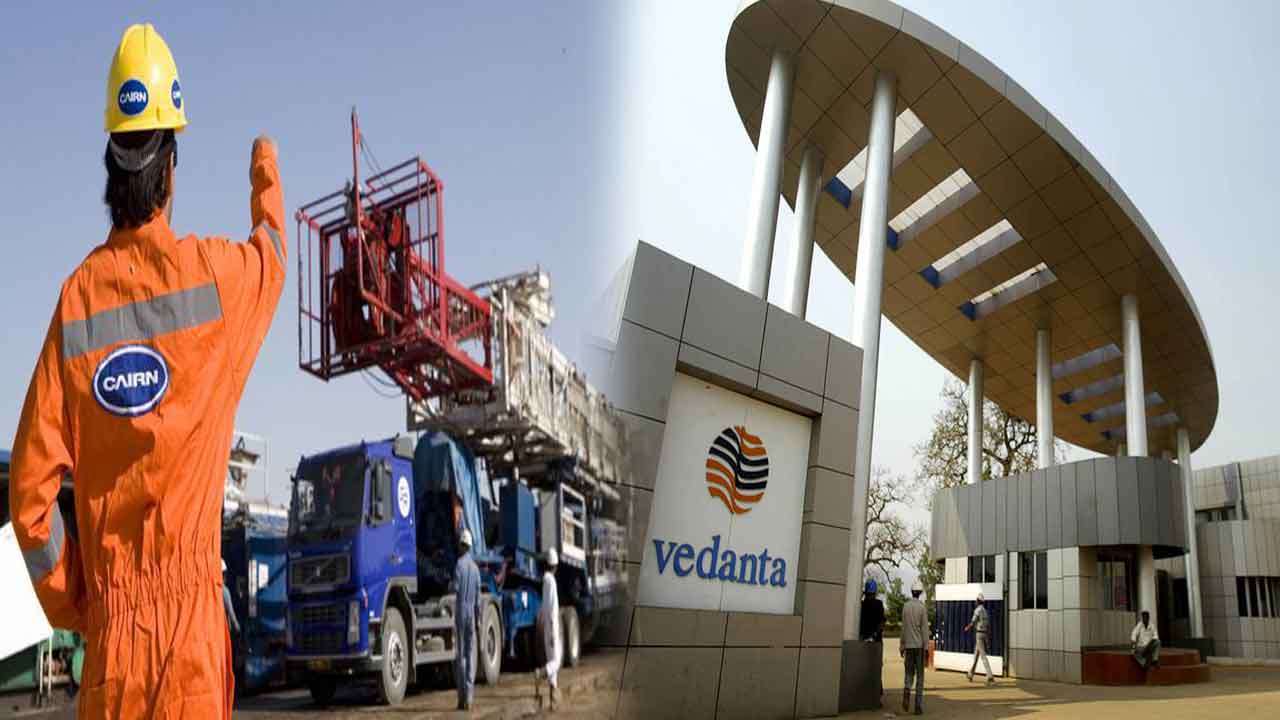After two years of negotiations with minority shareholders, facing regulatory hurdles and a lingering Rs 30,000-crore (including penalty) retrospective tax issues, the merger of cash-rich Cairn India with Vedanta is finally done. The merger – a $2.3 billion all-share deal — will consolidate Vedanta’s position as one of the world’s largest diversified natural resources companies like BHP Billiton and Rio Tinto and the merged entity will have a pro forma market cap of $15.6 billion. The merger will help Vedanta Resources reduce its debt. At the time of the merger talks, Cairn had cash and cash equivalents of about Rs 25,000 crore, while Vedanta had about Rs 78,000 crore of debt.
The company has fixed April 27 as the record date for determining the list of the shareholders of Cairn India to whom the equity and preference shares of Vedanta Ltd (earlier known as Sesa Sterlite) will be allotted. As decided during the merger, for each equity share held in Cairn India, investors will receive one equity share and four redeemable preference shares in Vedanta. Also, Cairn India shareholders will become shareholders of Vedanta and will receive an interim dividend of Rs 17.7 per equity share as approved by the board of Vedanta on March 30, 2017.
Resistance for the deal
The deal faced stiff resistance from Cairn India shareholders including Life Insurance Corporation of India (LIC), which has 9% stake in the company. In order to sweeten the deal, Vedanta and Cairn had announced a revised deal, or a sweetener, in July last year in which Vedanta offered minority shareholders of Cairn India one equity share and four redeemable preference shares with a face value of Rs 10 each. The preference shares will carry a coupon of 7.5% and tenure of 18 months. The revised deal implied a 20% premium to the one-month volume weighted average price of Cairn shares. The earlier deal in 2015 was one equity share and one redeemable preference share.
With the merger, the minority shareholders of Cairn India will hold a 20.2% stake in the merged entity, while Vedanta Plc’s ownership will be 50.1% and the remaining 29.7% will be owned by Vedanta’s minority shareholders. With the final restructuring, Vedanta Resources will keep majority control of Cairn India while getting better access to the cash on the balance sheet. There was resistance from Cairn shareholders that Vedanta will use the former’s cash reserve to pare debt. Even though Vedanta management led by London-based billionaire Anil Agarwal has assured that it will not use Cairn’s cash pile to repay debt, the fact remains that money is fungible, especially once the balance sheets of the two companies are merged and aligned.
Also, the Cairn-Vedanta merger involved the transfer of petroleum mining rights as well as production sharing contracts for the Rajasthan and other domestic exploration and production blocks, which required consent from the government as well as the JV partner – Oil and Natural Gas Corporation Ltd. In fact, in 2011, Vedanta Group acquired 58.5% controlling interest in Cairn India from its UK parent, Cairn Energy Plc. Of this, 20% was acquired by Vedanta Ltd and 38.5% by Twinstar Mauritius Holdings, Ltd, which is a special purpose vehicle wholly owned by Vedanta Resources Plc. The acquisition by TMHL was funded by $4.43 billion of debt funded partly by banks and by Cairn India. The deal got locked in a dispute with the government over the payment of royalty. Later the government gave conditional approval to the deal provided Cairn India treated royalty as a cost recoverable item, withdraw all arbitration proceedings and obtain a no-objection certificate from Oil and Natural Gas Corporation Ltd.
What the deal means to Vedanta and Cairn India
For Vedanta, the merger will simplify the group structure, de-risk earnings volatility and allow flexibility to allocate capital. Cairn India’s cash balance of Rs 2,500 crore will help in rationalizing Vedanta’s huge debt burden and reduce cost of funding. Also, after the merger, a loan of Rs 8,000 crore given by Cairn India to Vedanta will be waived.
Vedanta’s debt issues were attributable to regulatory hurdles and weak commodity prices, which hit the cash-flows of group companies. The gloomy macroeconomic environment for the commodities market as a result of sharp decline in commodity prices has had a negative impact on the net profits of Vedanta. For Cairn, the merger will help it to withstand commodity price shocks as in a volatile price environment, a stronger balance sheet can manage cash flows very well. The merger will also make Vedanta Resources less complex, with its subsidiaries coming down to four from nine in 2011.
As far as Cairn India is concerned, the deal will help it to diversify earnings from oil and gas to electricity and an array of commodities from copper to zinc to aluminum. The shareholders of Cairn India will also gain from Vedanta’s asset base and output increase forecast compared with Cairn India’s moderate output growth plan. Factoring in the preference share issue and dividend payout to Cairn’s shareholders, the merged entity is trading almost at par with Vedanta’s current stock price.
For both the companies, the merger is a win-win solution. While Vedanta gets Cairn India’s cash reserves to pare its debt, Cairn India’s shareholders will benefit from Vedanta’s cost-saving plan or marketing and procurement benefits. The merged entity will have a diversified product portfolio, which will enable Cairn India to overcome the cyclical downturn of oil prices and result in stable cash flows for it and it will also get access to Vedanta’s low-cost, longer lifecycle assets. Post-merger, the strong balance sheet will improve the credit rating of the combined entity, which will then provide an opportunity for refinancing.
Globally, such a similar merger to create an integrated natural resources player is rare. For instance, BHP Billiton, which is the largest integrated natural resources player in the world, entered into the shale gas business in 2011 by acquiring Petrohawk. Similarly, Freeport-McMoRan, one of the largest copper producing companies in the world hived off its oil business into a separate company in 1994. But in December 2012, the company merged its oil business and acquired another oil exploration company to replicate the BHP Billiton model. In some ways, the merger of Vedanta and Cairn India is one like that to create a global conglomerate.
Company Description
Cairn India
It is an independent oil and gas exploration company, owned by Vedanta Group, having taken over from Cairn Energy, UK. Cairn has stakes in the oil producing blocks – 70% in Rajasthan RJ-ON90/1, 22.5% in Revva and 40% in Cambay block CB-OS/2.In its largest field in Rajasthan, the company estimates gross proved and probable reserves and resources at 1.3 bn barrel of oil equivalent (boe) and gross recoverable risked prospective resources of 530 mmboe. Further, it has exploration potential in blocks in KG onshore and Sri Lanka, where it has made discoveries.
Vedanta
It is a subsidiary of Vedanta Resources, the London-listed metals and mining group. Vedanta is a globally leading diversified resources company with presence in oil and gas (though 58.9% stake in Cairn India, and now a merged entity), zinc-lead-silver (through 64.9% stake in Hindustan Zinc Ltd and 1005 stake in erstwhile zinc-lead business of Anglo American), copper, iron, ore, aluminum and commercial power, largely in standalone business but in subsidiaries as well. It has a 2,400 MW power plant in Orissa and is in the midst of adding another 1,980 MW capacity in Punjab.
The company was formed through the merger of Sterlite Industries into Sesa Goa along with the acquisition of additional 38.8% stake in Cairn in August 2013. Vedanta has entered the nonferrous metals sector as a pure-play copper producer and through several strategic acquisitions acquired aluminum as well as zinc-lead assets. The company has iron and ore mining assets in Goa and Karnataka with reserves of around 433 mt.
Though its subsidiaries, Vedanta Plc has operations across India, Zambia, Namibia, South Africa, Liberia, Ireland and Australia. It was listed on the London Stock Exchange in 2003 and will be the parent of the merged entity – Vedanta – after merge with Cairn India.
Conclusion
With the merger has been down, the merger entity must chalk out its expansion plan in India and other parts of the world. As the merged entity can now get funds as a lower cost from lenders, it can negotiate to acquire the residual stake in government-owned Hindustan Zinc and Balco. The pricing will have to be negotiated and the buyoff will benefit Vedanta Group in the long-run.




